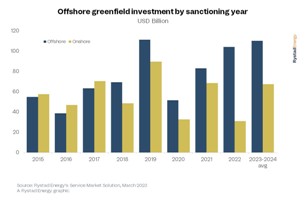The offshore oil and gas sector is set for the highest growth in a decade in the next two years, one of the main global drivers being the sizable expansion of offshore activities in the Middle East, according to Rystad Energy research
US$214bn of new project investments are lined up globally, according to Rystad Energy research, which shows that annual greenfield capital expenditure (capex) will break the US$100bn threshold in 2023 and in 2024 – the first breach for two straight years since 2012 and 2013.
As global fossil fuel demand remains strong and countries look for carbon-friendly production sources, offshore is back in the spotlight. Offshore activity is expected to account for 68% of all sanctioned conventional hydrocarbons in 2023 and 2024, up from 40% between 2015-2018, before Covid-19 pandemic and related oil price crash. In terms of total project count, offshore developments will make up almost half of all sanctioned projects in the next two years, up from just 29% from 2015-2018.
These new investments will be a boon for the offshore services market, with supply chain spending to grow 16% in 2023 and 2024, a decade-high year-on-year increase of US$21bn. Offshore rigs, vessels, subsea and floating production storage and offloading (FPSO) activity are all set to flourish.

For the first time, offshore upstream spending in the Middle East will surpass all others, lifted by mammoth projects in Saudi Arabia, Qatar and the UAE. The area’s offshore spending growth looks set to continue at least for the next three years, growing from US$33bn this year to US$41bn in 2025.
These countries are tapping into their vast offshore resources to meet rising global oil demand, backed by the necessary capital and infrastructure to outpace other producers. In long-term forecasts, Middle Eastern growth is set to continue, if not accelerate, according to Rystad.
“Offshore oil and gas production isn’t going anywhere, and the sector matters now possibly more than ever. As one of the lower carbon-intensive methods of extracting hydrocarbons, offshore operators and service companies should expect a windfall in the coming years as global superpowers try to reduce their carbon footprint while advancing the energy transition,” said Audun Martinsen, head of supply chain research with Rystad Energy.




